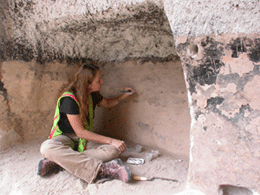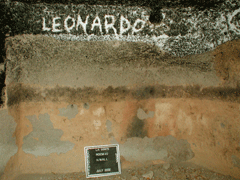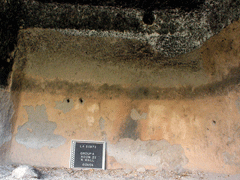The Writing on the Wall
Air Date: Week of June 13, 2008

Angelyn Bass Rivera, architectural conservator with the National Park Service, restores a section of a Bandelier cavate. (Courtesy of National Park Service)
Graffiti is plaguing many of our nation’s national parks and monuments, including some ancient Native American cliff dwellings. At Bandelier National Monument in New Mexico, conservators from a government program are taking advice from Natives, whose ancestors built these ancient sites, to make sure the restoration is done appropriately. KUNM’s Jim Williams reports.
Transcript
[MUSIC: Nicholas Payton: “Let It Ride” from Into The Blue (Nonesuch Records 2008)]
GELLERMAN: It’s Living on Earth. I’m Bruce Gellerman.
Graffiti’s typically found on subway cars and the walls and structures of the inner city. But far from the urban canyons you’ll also find graffiti in the remote canyons of New Mexico. At Bandelier National Monument in New Mexico, vandals have been desecrating the ancient cliff dwellings. And cleaning up the graffiti has created a conundrum – how to do it in a culturally appropriate way.
Jim Williams from public radio station KUNM has our story.
[OLD SCREEN DOOR SQUEAKING OPEN AND CLOSED]
WILLIAMS: Larry Humetewa steps out of his old stone building office with a couple of buckets. He’s about to head up the canyon trail here in New Mexico’s Bandelier National Monument to deal with graffiti park visitors have left on some of the 800 year old cliff dwellings.
HUME: We have to bring out our field material, which consists of a couple of different clays, some red tuff, grey tuff, trail sand, tools we call microspatulas.
WILLIAMS: Humetewa is on the restoration team for Vanishing Treasures, a National Park Service program that has, since the late 1990s, provided extra funding and expertise to help protect and stabilize ancient archeological sites at national parks and monuments across the Southwest. The program’s been called a “last defense” against losing sites like these. And there is plenty of defending to do. In the case of Bandelier’s graffiti, up to a quarter of the 1100 ancestral pueblo sites here have now been vandalized by visitors. Humetewa is from Santo Domingo Pueblo, a reservation about forty miles to the south. It’s likely his ancestors built these ancient dwellings.
HUME: You know, it’s very important. I do feel that connection, you know.
[FRIJOLES CREEK, WIND IN TREES]
WILLIAMS: Frijoles Creek runs through a beautiful forest of old ponderosa pine, douglas fir, and gambel oak along the canyon bottom here in Bandelier. Through the trees, on either side, the sun shines on cliff walls that rise hundreds of feet into the air. They’re filled with ancestral dwellings used by generations of American Indians. Humetewa glances up at them.
[WALKING ALONG CREEKSIDE TRAIL]
HUME: Every time I, you know, drive down the hill, it’s a special place. And knowing that my ancestors lived here and played here and worked here, and made pots and textiles here. You know, I try to stay positive while I’m working, you know basically what we’re always told to do: just stay positive, respect the place and the people that lived here.
WILLIAMS: On the way up the trail toward the cliffs, we pass a sign that states clearly: “it’s illegal to deface cave dwellings.”
HUME: Yeah, I think they oughta, I don’t know, put more signs in different languages. [laughs] I don’t know. They just seem to ignore them. Even way down there where we’re working at, there’s signs, you know, right in front of you.
[CLIMBING SQUEAKY WOODEN LADDER]
WILLIAMS: We climb the ladder made out of small logs up into one of the cavates, a round room about eight feet high and fifteen feet deep carved into the compressed volcanic ash, or “tuff,” of the cliff wall.
HUME: We probably started “c”, and then an “o” over here.
WILLIAMS: Humetewa waves his hand across where someone had carved the name of an old Spanish conquistador, Coronado. In another spot, a visitor had written his own name: Leonardo. That one was difficult to cover because it sprawled across the wall. But if Humetewa wasn’t pointing at it, no one would ever know it’d been there.

Leonardo carved his name on this ancient cavate wall. (Courtesy of National Park Service)

The same cavate wall after graffiti mitigation treatment. (Courtesy of National Park Service)
WILLIAMS: That’s clearly important to Humetewa, because he takes the graffiti personally.
HUME: To me, it’s like coming into my house and carving your name on my wall. You know, that’s how I feel that these are disrespectful. I wouldn’t go into anybody’s house and carve my name into their wall.
WILLIAMS: For the restoration, the process of color and texture matching is meticulous: tuff mixed with trail sand, lime, ionized water, and pigment. The mix and the application have to be rough-textured to match the way the walls are naturally eroding.
[SCRAPING AND MIXING IN A SMALL CUP]
HUME: Yeah, you don’t wanna add too much water ‘cause it’s just gonna get too watery…
[SPRAYING WATER]
WILLIAMS: Humetewa sprays water over the graffiti to moisten the wall so the material will stick to it. The mix is then carefully applied by spatula over the carved graffiti.
[SPATULA SCRAPES, FADE DOWN TO SILENCE]
[FADE UP, VISITORS TALKING IN ANOTHER CAVE]
MCMAHON: The graffiti in this cave is so severe…before it was treated it was so severe that there was basically little to no original material left.
WILLIAMS: That’s Conor McMahon, Humetewa’s restoration partner. This cavate, about three hundred feet down the cliff from the other, originally had a black ceiling, created by centuries of smoke from burning wood in it. It has, over time, become a chalkboard of sorts for people to carve their own messages: initials, names, profanity. McMahon says that here, he and Humetewa had to break from their traditional method of just covering over individual graffiti markings. As many as four times a year, in the hot high desert sun, they have to re-soot the whole thing.

Angelyn Bass Rivera, Architectural Conservator with the National Park Service, restores a section of a Bandelier cavate. Graffiti mitigation involves the infilling of graffiti that has been etched or carved into the original tuff and plaster surfaces in the cavates. (Courtesy of National Park Service)
WILLIAMS: This room, and many others like it here, were sacred places for generations, and to their descendants they still are.
MEYER: Their perspective on sites like this are that these sites are still occupied by their ancestors - that life is very cyclical.
WILLIAMS: Lauren Meyer is an architectural conservator with the Vanishing Treasures Program at Bandelier. She says the program has consulted with the current pueblo people in the area, including Larry Humetewa, to make sure restoration is done correctly.
MEYER: You know, their ancestors live on in these sites, and these sites, you know, are supposed to erode naturally. It’s all about coming from the earth and going back to the earth, and Larry brings that perspective to us which helps inform our decisions about treating these sites.
[BIRDS, CREEK]
WILLIAMS: About 25,000 dollars a year is dedicated to treating these sites at Bandelier. Lauren Meyer and other preservation advocates say that's barely enough to continually treat these sites and educate the public about their cultural history. The Vanishing Treasures program focuses almost exclusively on Southwest parks, where many ancient cultural sites exist. But other national parks and monuments around the country have little funding for restoration programs. One former parks director called the lack of funding "an undeniable crisis in care" and it's sure to affect historical parks around the country for years to come.
For Living On Earth, I'm Jim Williams in Bandelier National Monument in New Mexico.
Links
Living on Earth wants to hear from you!
Living on Earth
62 Calef Highway, Suite 212
Lee, NH 03861
Telephone: 617-287-4121
E-mail: comments@loe.org
Newsletter [Click here]
Donate to Living on Earth!
Living on Earth is an independent media program and relies entirely on contributions from listeners and institutions supporting public service. Please donate now to preserve an independent environmental voice.
NewsletterLiving on Earth offers a weekly delivery of the show's rundown to your mailbox. Sign up for our newsletter today!
 Sailors For The Sea: Be the change you want to sea.
Sailors For The Sea: Be the change you want to sea.
 The Grantham Foundation for the Protection of the Environment: Committed to protecting and improving the health of the global environment.
The Grantham Foundation for the Protection of the Environment: Committed to protecting and improving the health of the global environment.
 Contribute to Living on Earth and receive, as our gift to you, an archival print of one of Mark Seth Lender's extraordinary wildlife photographs. Follow the link to see Mark's current collection of photographs.
Contribute to Living on Earth and receive, as our gift to you, an archival print of one of Mark Seth Lender's extraordinary wildlife photographs. Follow the link to see Mark's current collection of photographs.
 Buy a signed copy of Mark Seth Lender's book Smeagull the Seagull & support Living on Earth
Buy a signed copy of Mark Seth Lender's book Smeagull the Seagull & support Living on Earth

